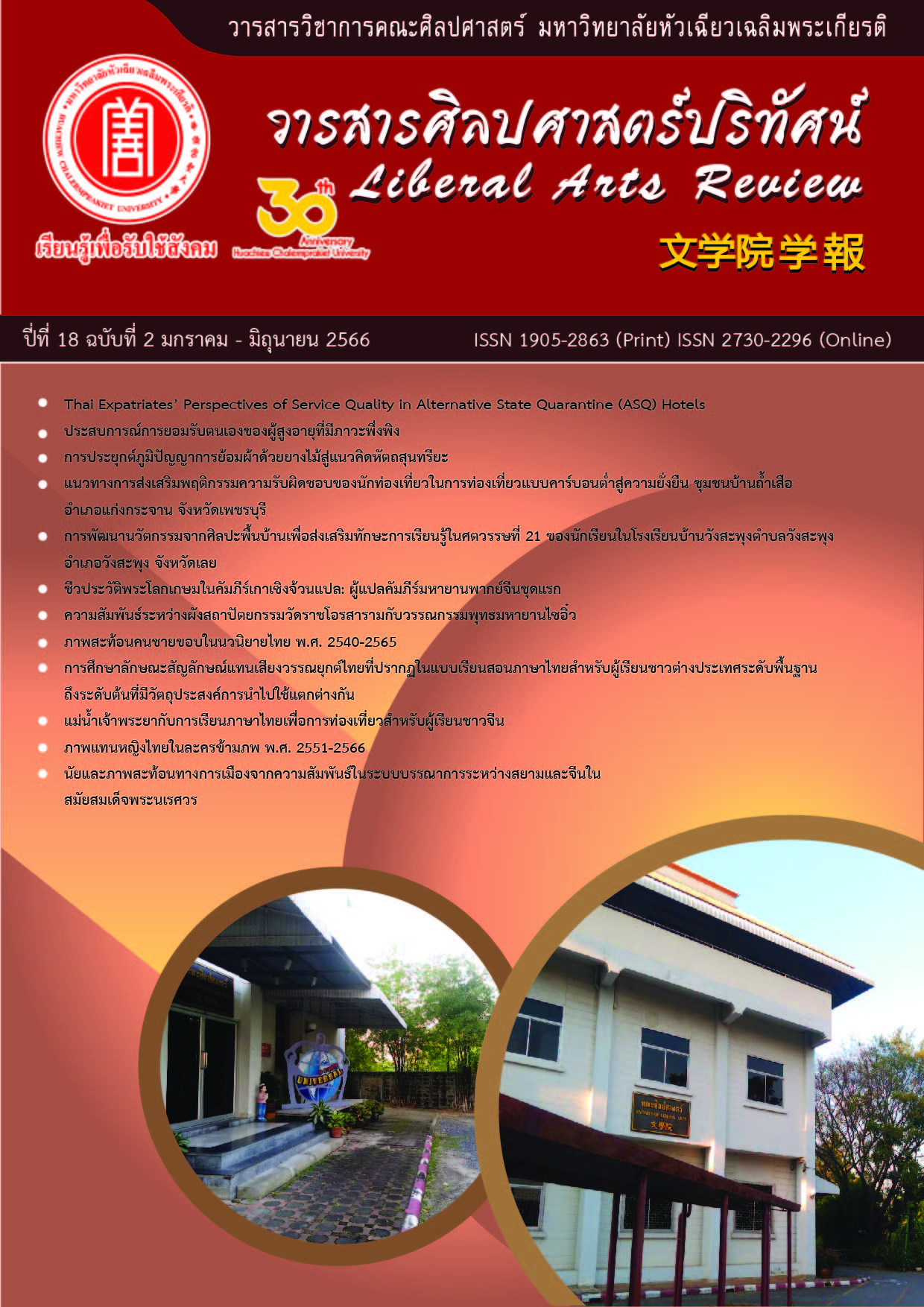Chao Phraya River and the study of Thai for Tourism for Chinese Learners
DOI:
https://doi.org/10.14456/lar.2023.19Keywords:
Chao Phraya River, Thai for Tourism, Chinese learnersAbstract
This article’s objective is to study the importance of the Chao Phraya River as a significant medium for the study of Thai Language for Tourism among Chinese learners. The researcher has analyzed and collected data from three sources which are 1) the Thai textbook of Chinese learners, 2) the Chinese learners’ questionnaire, and 3) the fieldwork in the Chao Phraya River area. The result shows that Chao Phraya River is mentioned in Thai Fundamental Textbook III (黄进炎, & 林秀梅, 2009) for Chinese learners. This suggests that the learning about Chao Phraya River is one of the significant topics in teaching and learning Thai language in China. According to the questionnaire, Chinese learners suggest adding more content about traveling in the Chao Phraya River area. In addition, due to the fieldwork study on the Chao Phraya River, the researcher finds that both shores of Chao Phraya have several remarkable tourist attractions, which can be spotted from distance and located nearby the piers, which are Yannawa Temple, The Temple of Dawn (Wat Arun), The Royal Palace, Wat Rakhang Khositaram Woramahawiharn, Wang Lang Market, ICONSIAM Department Store, and Asiatique the Riverfront. They are located near six piers, which are Sathorn Pier, ICONSIAM Pier, Wat Arun Pier, Tha Chang Pier, Wang Lang Pier, and Asiatique Pier. All these seven landmarks are important in the study of Thai Language for Tourism among Chinese learners in three aspects: historical, architectural, and social of the Thai lifestyle by the river. They help Chinese learners improve and develop Thai Tourism skills and get to know better about Thailand.
References
กรมประชาสัมพันธ์. (2565). โฆษกรัฐบาลเผย นายกฯ ปลื้มผลการจัดอันดับ Reader's Choice Awards 2022 ของนิตยสาร DestinAsian จัดให้ ‘กรุงเทพฯ’ เป็น Best City รวมทั้ง ภูเก็ต สมุย ครองอันดับ 3 และ 4 เกาะที่ดีที่สุด. ค้นคืนจาก https://www.prd.go.th/th/content/page/index/id/83669.
การท่องเที่ยวแห่งประเทศไทย. (2556). ทรัพยากรการท่องเที่ยวไทยชุดภาคกลางและภาคตะวันออก. กรุงเทพมหานคร: ฝ่ายส่งเสริมสินค้าการท่องเที่ยว การท่องเที่ยวแห่งประเทศไทย.
ชาตรี ประกิตนนทการ. (2556). คติสัญลักษณ์และการออกแบบวัดอรุณราชวราราม. กรุงเทพมหานคร: อมรินทร์พริ้นติ้งแอนด์พับลิชชิ่ง.
ฐิติมา ไทยวงษ์. (2556). แรงจูงใจในการท่องเที่ยวที่มีความสัมพันธ์กับพฤติกรรมการท่องเที่ยวของนักท่องเที่ยวไทยในเอเซียทีค เดอะ ริเวอร์ฟร้อนท์. (วิทยานิพนธ์ปริญญามหาบัณฑิต). มหาวิทยาลัยศรีนครินทรวิโรฒ, กรุงเทพมหานคร.
ตาน เผิง. (2565). การสร้างหนังสืออิเล็กทรอนิกส์ภาษาไทยเพื่อการท่องเที่ยว เรื่อง “ภูมิสัญลักษณ์กรุงเทพฯ” สำหรับผู้เรียนชาวจีน. (วิทยานิพนธ์ปริญญามหาบัณฑิต). มหาวิทยาลัยศรีนครินทรวิโรฒ, กรุงเทพมหานคร.
ไทยรัฐออนไลน์. (2565). เช็กรอบแสดงพลุ แสง สี 6 จุดริมแม่น้ำเจ้าพระยา กทม. รับ เอเปก 2022. ค้นคืนจาก https://www.thairath.co.th/lifestyle/travel/2551626.
ธนากร ฉัตรโรจนสกุล. (2565). การสร้างหนังสืออิเล็กทรอนิกส์ภาษาไทยเพื่อการท่องเที่ยว เรื่อง “ย่านเก่าแก่ฝั่งธน-ฝั่งพระนคร” ตามเส้นทางรถไฟฟ้ามหานครส่วนต่อขยาย 2562” สำหรับผู้เรียนชาวจีน. (วิทยานิพนธ์ปริญญามหาบัณฑิต). มหาวิทยาลัยศรีนครินทรวิโรฒ, กรุงเทพมหานคร.
แน่งน้อย ศักดิ์ศรี. (2544). สถาปัตยกรรมไทย (พิมพ์ครั้งที่ 3). กรุงเทพมหานคร: โรงพิมพ์จุฬาลงกรณ์มหาวิทยาลัย.
หมิงชาน เซี่ย. (2565). การสร้างหนังสืออิเล็กทรอนิกส์ภาษาไทยเพื่อการท่องเที่ยว เรื่อง “เสน่ห์แห่งวัดโพธิ์” สำหรับผู้เรียนชาวจีน. (วิทยานิพนธ์ปริญญามหาบัณฑิต). มหาวิทยาลัยศรีนครินทรวิโรฒ, กรุงเทพมหานคร.
ยิ่นเฟย เฉิน. (2562). สภาพการเรียนภาษาไทยของนักศึกษาชาวจีน สาขาวิชาภาษาไทย ระดับปริญญาตรีในมหาวิทยาลัย ณ มณฑลยูนนาน สาธารณรัฐประชาชนจีน. (วิทยานิพนธ์ปริญญามหาบัณฑิต). มหาวิทยาลัยศรีนครินทรวิโรฒ, กรุงเทพมหานคร.
ศิลปวัฒนธรรม. (2564). รำลึกวังหลัง วังของ “หลาน” รัชกาลที่ 1 และร่องรอยที่เหลือจากอดีตใน “ตรอกวังหลัง”. ค้นคืนจาก https://www.silpa-mag.com/history/article_10201.
สุภรณ์ อัตถาวงศ์, เกรียงไกร โพธิ์มณี, ขวัญมิ่ง คำประเสริฐ, และ สุภาภรณ์ พรหมฤๅษี. (2564). ยุทธศาสตร์การพัฒนาธุรกิจท่องเที่ยวทางแม่น้ำเจ้าพระยาสำหรับนักท่องเที่ยวชาวจีนในเขตกรุงเทพมหานคร. วารสารสังคมศาสตร์และมานุษยวิทยาเชิงพุทธ, 6(2), 361-374.
อรัญญา แสนสระ. (2565). “ตลาดในชีวิต ชีวิตในตลาด” รวมภาพสะท้อนวิถีชีวิตและมิติทางวัฒนธรรมของชุมชน. วารสารศิลปศาสตร์ มหาวิทยาลัยเทคโนโลยีราชมงคลธัญบุรี, 3(2), 102-104.
อุดม เชยกีวงศ์. (2552). ตลาดน้ำ : วิถีชีวิตของชุมชนที่อาศัยอยู่ริมแม่น้ำ. กรุงเทพมหานคร: ภูมิปัญญาสร้างสรรค์.
College of Foreign Languages, Peking University. (2021). The national first-class undergraduate major construction site of College of Foreign Languages, Peking University: Thai Language. Retrieved from https://sfl.pku.edu.cn/jxgl/bks/ylzyjs/133298.html.
LIU, L. (2023). List and ranking of schools offering Thai language majors across the country in 2023. Retrieved from http://m.zhongkaohelp.com/gaokao/zhuanyejieshao/60064.html.
黄进炎, & 林秀梅.(2009). 基础泰语(3). 广州: 世界图书出版公司.
苏柳. (2019). 基于四川省泰语导游口试现状的《旅游泰语》课程教学改革探究.
长江丛刊,2019(27), 60-61.
Downloads
Published
How to Cite
Issue
Section
License
Copyright (c) 2023 Liberal Arts Review

This work is licensed under a Creative Commons Attribution-NonCommercial-NoDerivatives 4.0 International License.
บทความที่ได้รับการตีพิมพ์เป็นลิขสิทธิ์ของวารสารศิลปศาสตร์วิชาการและวิจัย
ข้อความที่ปรากฏในบทความแต่ละเรื่องในวารสารวิชาการเล่มนี้เป็นความคิดเห็นส่วนตัวของผู้เขียนแต่ละท่านไม่เกี่ยวข้องกับมหาวิทยาลัยหัวเฉียวเฉลิมพระเกียรติ และคณาจารย์ท่านอื่นๆ ในมหาวิทยาลัยฯ แต่อย่างใด ความรับผิดชอบองค์ประกอบทั้งหมดของบทความแต่ละเรื่องเป็นของผู้เขียนแต่ละท่าน หากมีความผิดพลาดใดๆ ผู้เขียนแต่ละท่านจะรับผิดชอบบทความของตนเองแต่ผู้เดียว




